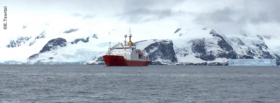Ocean – ice sheet interaction
The interface between oceans and ice sheets plays an important role at the future melting of ice sheets, still however, the processes which occur at this interface are only poorly understood and therefore, the interface is not well represented in climate models (Joughin et al., 2012). Changes in ocean dynamics and heat supply lead to thinning of ice shelves and subsequently reduced buttressing, causing an acceleration of the draining ice streams (Joughin et al., 2012). Increased ice discharge also contributes to the thermo- and halosteric sea level change through melting of icebergs distributed by ocean currents. Ice sheet instability, occurring from the retreat of grounding lines of marine ice sheets, is a second factor that influences regional sea level change. Evidence emerges that the accelerated melting and retreat of glaciers and ice sheets contribute significantly to recent and future sea level change (Rignot et al., 2011). However, our understanding of contemporary and future contributions from ice melt to regional sea level change is only rudimentary.
To make progress, we need to investigate:
- what are the changes in the ocean circulation and respective transports of warm water onto the continental shelves;
- what is the response of ice sheets to this warmer water and their internal variability;
- what is the solid Earth response to ice sheet mass loss.
Answering those questions specifically requires to examine the ice-ocean interaction, grounding line dynamics and calving of outlet glaciers, as well as the ocean dynamics in fjords including ventilation, plumes and the transport mechanisms of warm deep water onto the shelf, the response of the solid Earth to ice load changes and self-gravitation (e.g., Hellmer et al., 2012).

